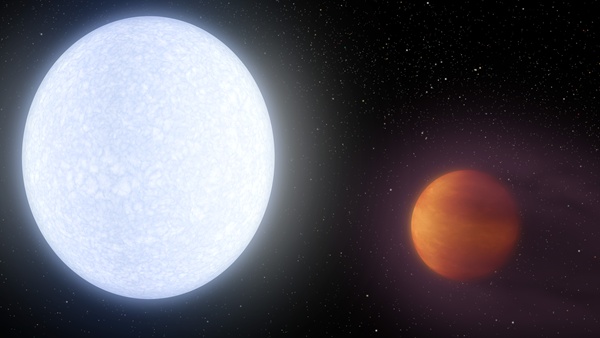This gas giant gives “hot Jupiter” a whole new meaning.
Astronomers with the Kilodegree Extremely Little Telescope(s) (KELT) survey have just announced an amazing find: the hottest gas giant ever discovered. In fact, the planet is so hot that it’s hotter than most stars, and it’s only a few thousand degrees cooler than our own Sun.
The planet, KELT-9b, is about three times the mass of Jupiter and twice its size. Its discovery was announced by B. Scott Gaudi of The Ohio State University and Karen Collins of Vanderbilt University at a press conference Monday afternoon at the 230th Meeting of the American Astronomical Society in Austin, Texas. “We are very excited today to announce the discovery of KELT-9b … a gas giant planet hotter than most stars. And I want to emphasize that’s not a typo,” Collins said during the press conference. She went on to explain that KELT-9b is so hot because of its sun, “the brightest, hottest, most massive known transiting gas giant planet host star.” Concurrent with the announcement, the work was also published online as a letter in Nature.
That host star is roughly 2.5 times the mass of our Sun, and is rotating so quickly (about once a day) that it’s more of a flattened egg shape than a sphere, like the planet Saturn. Every time KELT-9b transits across the face of its sun, the light coming from the star drops by only one half of one percent. The star, which is a hot, blue star, radiates not only in the optical, but also puts out huge amounts of ultraviolet (UV) light. Its massive output, coupled with KELT-9b’s close proximity, boosts the temperature on the planet’s day side to about 7,800 degrees Fahrenheit (4,300 Celsius). Because the planet is tidally locked, the same side always faces its parent star; astronomers currently think that the night side is much cooler, due to the atmosphere’s poor ability to transfer heat from the broiling day side to the rest of the planet. But even still, that “cool” side is hot: “The night side would probably look like a red dwarf to our eyes,” Gaudi said at the press conference.
Furthermore, KELT-9b is orbiting its star perpendicular to the host’s axis of rotation. That means rather than circling in the same plane as the star’s equator, as our planets circle the Sun, KELT-9b flies over its parent star’s north and south poles with every 1.5-day orbit it completes. This odd orbit, Gaudi said, likely precesses as well, which means the planet may stop transiting its sun as seen from Earth within about 150 years, depending on the rate of this precession. Astronomers would then have to wait several thousand years before transits could be seen again.
But one of the oddest things about KELT-9b may be the fact that it’s evaporating. Its parent star puts out so much UV radiation (700 times more than the UV radiation imparted on any other known gas giant) that “the planet is almost certainly being evaporated by the high-energy photons,” explained Gaudi. Although there is no firm measurement of how fast it’s losing gas, Gaudi went on to say that KELT-9b could be shedding its atmosphere at a rate between 10 billion and 10 trillion grams per second. As a result, the planet likely sports a comet-like tail as it zips around its sun.
Whether the planet will fully evaporate before its host star expands into its red giant phase is still up in the air. Either way, Keivan Stassun, part of the discovery team and a professor of physics and astronomy at Vanderbilt University, said in an accompanying press release, “The long-term prospects for life, or real estate for that matter, on KELT-9b are not looking good.”
Maybe not, but the system is still intriguing and, as of right now, unique. “It’s going to be a great system for us to study with HST, Spitzer, and eventually [the] James Webb Space Telescope, not to mention ground-based facilities.” said Gaudi. “We’re really looking forward to trying to characterize the properties of this planet and understand it better.”
The KELT survey focuses primarily on bright stars because the telescopes it uses are small. Half of its target stars are both hotter and more massive than the Sun, a parameter space not typically explored by other exoplanet searches. Thus, KELT-9b may only be the first of many extremely hot gas giants this survey turns up.
Source: Astronomy.com

































Leave a Comment
You must be logged in to post a comment.